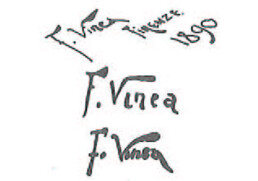
Vinea Francesco *
VINEA FRANCESCO
Forlì 1845 – Firenze 1902
Trasferitosi a Firenze con la famiglia fin da bambino, frequentò dal 1859 i corsi di E. Pollastrini all’Accademia di Belle Arti di quella città, ma presto dovette lasciare la scuola per problemi economici. Si impiegò in uno studio fotografico, dedicandosi nel frattempo al lavoro di illustratore per il quale si esercitò nella copia di opere d’arte del passato. In quegli anni dipinse soggetti di ricostruzione storica, nei quali è riconoscibile il modello di P. Delaroche, ma fu anche vicino ai fermenti innovativi degli artisti del Caffè Michelangiolo. Nel 1861 esordì alla prima Esposizione Nazionale di Firenze con un Ritratto muliebre e nel 1863 ebbe l’incarico di dipingere Michelangelo che recita i suoi versi a Vittoria Colonna, da collocarsi negli appartamenti reali di Palazzo Pitti. Dal 1870 iniziò a inviare alle esposizioni quadri di genere, alla J. L. Meissonier, che gli aprirono le porte del mercato d’arte internazionale (Una Venere giapponese, I medici all’Antignano, La fioraia, esposti ad Anversa nel 1885). In una parallela applicazione ai temi di paesaggio e agresti, seguì, con modi personali, gli indirizzi delle contemporanee esperienze del Naturalismo toscano (Donna al torrente, 1889, coll. privata). Fu uno degli artisti legati alla galleria fiorentina di L. Pisani.
